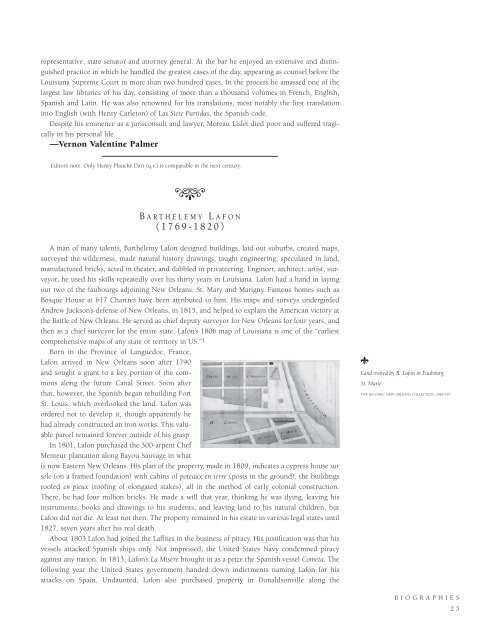Notable New Orleanians: A Tricentennial Tribute
An illustrated history of New Orleans paired with the histories of companies that have helped shape the city.
An illustrated history of New Orleans paired with the histories of companies that have helped shape the city.
You also want an ePaper? Increase the reach of your titles
YUMPU automatically turns print PDFs into web optimized ePapers that Google loves.
epresentative, state senator and attorney general. At the bar he enjoyed an extensive and distinguished<br />
practice in which he handled the greatest cases of the day, appearing as counsel before the<br />
Louisiana Supreme Court in more than two hundred cases. In the process he amassed one of the<br />
largest law libraries of his day, consisting of more than a thousand volumes in French, English,<br />
Spanish and Latin. He was also renowned for his translations, most notably the first translation<br />
into English (with Henry Carleton) of Las Siete Partidas, the Spanish code.<br />
Despite his eminence as a jurisconsult and lawyer, Moreau Lislet died poor and suffered tragically<br />
in his personal life.<br />
—Vernon Valentine Palmer<br />
Editor’s note: Only Henry Plauché Dart (q.v.) is comparable in the next century.<br />
B ARTHÉLEMY<br />
(1769-1820)<br />
L AFON<br />
A man of many talents, Barthélemy Lafon designed buildings, laid out suburbs, created maps,<br />
surveyed the wilderness, made natural history drawings, taught engineering, speculated in land,<br />
manufactured bricks, acted in theater, and dabbled in privateering. Engineer, architect, artist, surveyor,<br />
he used his skills repeatedly over his thirty years in Louisiana. Lafon had a hand in laying<br />
out two of the faubourgs adjoining <strong>New</strong> Orleans, St. Mary and Marigny. Famous homes such as<br />
Bosque House at 617 Chartres have been attributed to him. His maps and surveys undergirded<br />
Andrew Jackson’s defense of <strong>New</strong> Orleans, in 1815, and helped to explain the American victory at<br />
the Battle of <strong>New</strong> Orleans. He served as chief deputy surveyor for <strong>New</strong> Orleans for four years, and<br />
then as a chief surveyor for the entire state. Lafon’s 1806 map of Louisiana is one of the “earliest<br />
comprehensive maps of any state or territory in US.” 1<br />
Born in the Province of Languedoc, France,<br />
Lafon arrived in <strong>New</strong> Orleans soon after 1790<br />
and sought a grant to a key portion of the commons<br />
along the future Canal Street. Soon after<br />
that, however, the Spanish began rebuilding Fort<br />
St. Louis, which overlooked the land. Lafon was<br />
ordered not to develop it, though apparently he<br />
had already constructed an iron works. This valuable<br />
parcel remained forever outside of his grasp.<br />
In 1801, Lafon purchased the 300-arpent Chef<br />
Menteur plantation along Bayou Sauvage in what<br />
is now Eastern <strong>New</strong> Orleans. His plan of the property, made in 1809, indicates a cypress house sur<br />
sole (on a framed foundation) with cabins of poteaux en terre (posts in the ground), the buildings<br />
roofed en pieux (roofing of elongated stakes), all in the method of early colonial construction.<br />
There, he had four million bricks. He made a will that year, thinking he was dying, leaving his<br />
instruments, books and drawings to his students, and leaving land to his natural children, but<br />
Lafon did not die. At least not then. The property remained in his estate in various legal states until<br />
1827, seven years after his real death.<br />
About 1803 Lafon had joined the Laffites in the business of piracy. His justification was that his<br />
vessels attacked Spanish ships only. Not impressed, the United States Navy condemned piracy<br />
against any nation. In 1813, Lafon’s La Misère brought in as a prize the Spanish vessel Cometa. The<br />
following year the United States government handed down indictments naming Lafon for his<br />
attacks on Spain. Undaunted, Lafon also purchased property in Donaldsonville along the<br />
<br />
Land owned by B. Lafon in Faubourg<br />
St. Marie.<br />
THE HISTORIC NEW ORLEANS COLLECTION, 1980.187.<br />
BIOGRAPHIES<br />
25
















